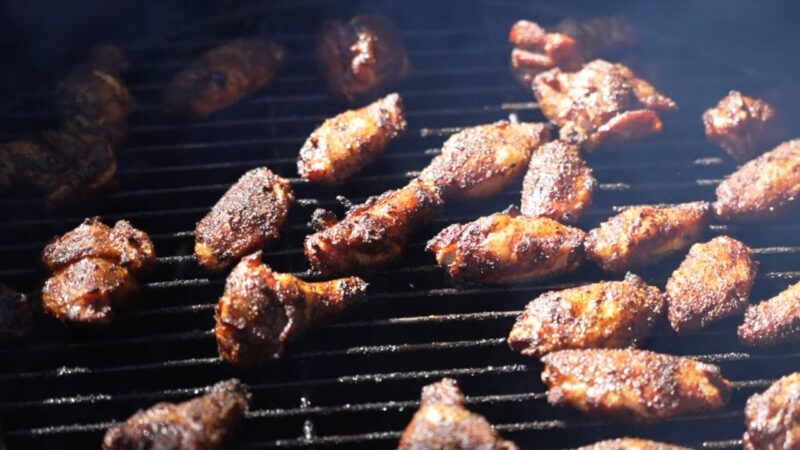Smoking chicken wings is an art that combines the right balance of temperature, time, and seasoning to create a mouth-watering delicacy. Understanding how long to smoke chicken wings at various temperatures is crucial because that is the only way to secure the perfect chicken every time.
It is a popular cooking method that infuses the meat with a rich, smoky flavor. Unlike grilling or frying, smoking requires patience and precision, but the result is well worth the wait. The key to successful smoking is maintaining a consistent temperature and giving the wings enough time to absorb the smoke flavor.
Before you start smoking your chicken wings, you’ll need a few essential tools and ingredients. A reliable smoker, quality wood chips, and a good meat thermometer are crucial. Here are the essentials you will need.
| Category | Item | Description |
|---|---|---|
| Tools | Smoker | A device used for smoking meats. Different types include charcoal, electric, and gas smokers. |
| Charcoal or Wood Chips | Used to create smoke and flavor. The type of wood can vary depending on desired flavor. | |
| Chimney Starter (for charcoal) | A tool to start charcoal more easily and safely. | |
| Meat Thermometer | To ensure the chicken reaches the safe internal temperature of 165°F (74°C). | |
| Tongs | For handling and flipping the chicken. | |
| Aluminum Foil | To wrap and rest the chicken after smoking, helping to retain juices. | |
| Basting Brush | For applying marinades or sauces during the smoking process. | |
| Ingredients | Whole Chicken or Chicken Parts | Depending on preference, you can smoke a whole chicken or specific parts like wings or thighs. |
| Brine or Marinade | A liquid solution to soak the chicken in before smoking, enhancing flavor and moisture. | |
| Rub | A mixture of spices and herbs applied to the chicken’s surface for additional flavor. | |
| Wood Chips | Depending on the smoker, you might need specific types of wood chips for flavor. | |
| Cooking Oil or Spray | To prevent sticking and help crisp the skin. | |
| Barbecue Sauce (optional) | For additional flavor, applied during or after smoking. |
How to Determine the Right Time?
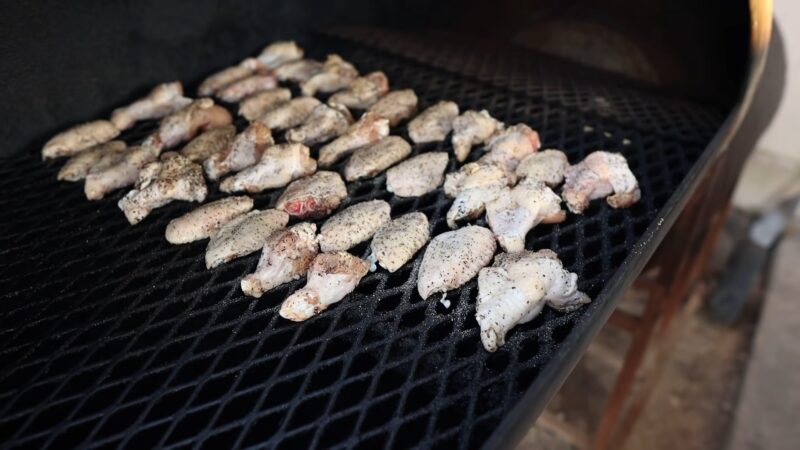
The temperature at which you smoke your chicken wings will significantly impact the cooking time and final result.
Low and Slow: 225°F (107°C)
Smoking chicken wings at 225°F is the classic low and slow method. This temperature allows the fat to render slowly, resulting in tender and juicy wings. Expect to smoke the wings for 2-3 hours at this temperature. The key is to be patient and let the wings cook gradually.
- Pros: Tender and juicy wings, rich smoke flavor
- Cons: Longer cooking time, requires more attention to maintain temperature
- Tips: Use a water pan to help maintain humidity and temperature
Medium Heat: 250°F (121°C)
At 250°F, you’re increasing the heat slightly but still allowing for a slow cooking process. The wings will take 1.5-2 hours to smoke at this temperature. This setting is a good middle ground for those who want a faster cook time without sacrificing too much tenderness.
- Pros: Faster cooking time than low and slow, still yields tender wings
- Cons: Slightly less smoke flavor than lower temperatures
- Tips: Baste the wings with sauce during the last 30 minutes of cooking for added flavor
Hot and Fast: 275°F (135°C) and Above
For those short on time, smoking chicken wings at 275°F or higher is the way to go. The wings will be ready in 1-1.5 hours, but be careful not to dry them out. This method requires a careful balance of time and temperature to ensure the wings are cooked through but still juicy.
- Pros: Quick cooking time, crispy skin
- Cons: Risk of drying out the wings, less smoke flavor
- Tips: Keep a close eye on the internal temperature to avoid overcooking
Selection of Wood Can Make a Difference
The type of wood chips you choose for smoking will significantly impact the flavor of your chicken wings.
Fruit Woods: Apple, Cherry, and Peach
Fruit woods are a popular choice for smoking chicken wings due to their mild and sweet flavor profile. Apple wood imparts a subtle sweetness, while cherry wood adds a hint of tartness. Peach wood is another excellent option, offering a sweet and fruity flavor.
Hard Woods: Hickory and Mesquite
For a more robust smoke flavor, consider using hickory or mesquite wood chips. Hickory provides a strong, bacon-like flavor, while mesquite offers an intense and earthy taste. Be cautious with mesquite, as it can become overpowering if used excessively.
Experiment with Wood Combinations
Don’t be afraid to experiment with different wood blends to create your unique flavor profile. Mixing fruit and hard woods can offer a balanced and complex taste that enhances the natural flavors of the chicken wings. Just be sure to start with small amounts and adjust according to your preference.
Tips and Tricks for Perfect Smoked Chicken Wings
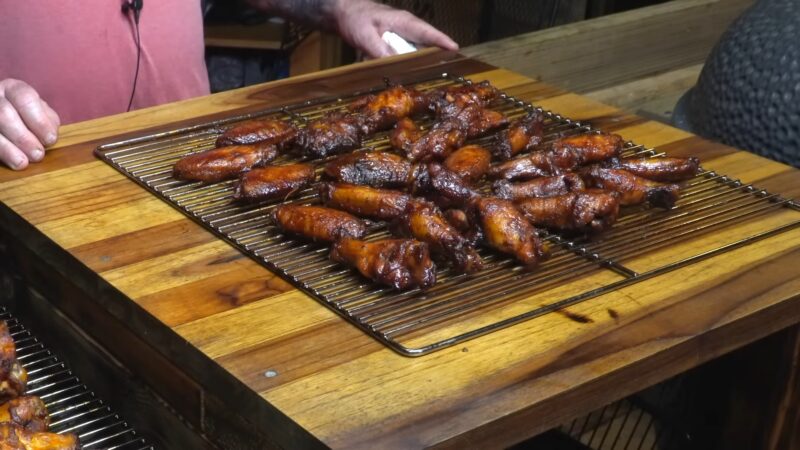
Achieving the perfect smoked chicken wings requires more than just time and temperature. In this section, we’ll share some expert tips and tricks to help you elevate your smoking game.
Prepare Meat For Smoking
Properly preparing the wings before smoking is crucial. Ensure they are thoroughly thawed, and pat them dry to remove any excess moisture. You can also remove the wing tips and separate the flats and drumettes for more even cooking.
Don’t Forget About Seasoning
Choosing the right seasonings and marinades can make or break your smoked chicken wings. Dry rubs and marinades should be applied at least an hour before smoking, allowing the flavors to penetrate the meat. Don’t be afraid to get creative with your flavor combinations!
Monitoring and Resting
Using a meat thermometer is essential to ensure your wings are cooked to perfection. The internal temperature should reach 165°F (74°C) for safe consumption. Once the wings are done, let them rest for a few minutes before serving to allow the juices to redistribute.
Good Spices Are Essential
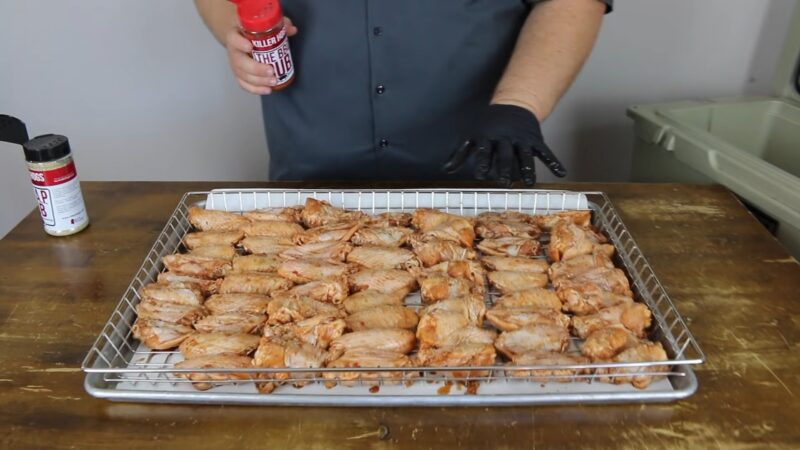
The spice blend you choose for your chicken wings can significantly impact their flavor. Whether you prefer classic BBQ, spicy Cajun, or exotic Asian flavors, the key is to balance the spices with the smoke.
Don’t be afraid to experiment with different herbs and spices until you find the perfect blend for your palate.
- Classic BBQ: A blend of paprika, brown sugar, garlic powder, onion powder, and a touch of cayenne for heat.
- Spicy Cajun: A fiery mix of cayenne pepper, paprika, garlic powder, onion powder, and thyme.
- Exotic Asian: A combination of five-spice powder, ginger, garlic powder, and a hint of brown sugar for sweetness.
Learning more about different spices and their features is the best approach to choose the right combination.
| Spice | Spiciness Level | Notes |
|---|---|---|
| Paprika | Mild | Adds a sweet and smoky flavor; use smoked paprika for an extra smoky taste. |
| Black Pepper | Medium | Provides a sharp and pungent flavor. Freshly ground is preferred for best taste. |
| Cayenne Pepper | Hot | Adds heat; adjust according to your spice tolerance. |
| Chili Powder | Medium-Hot | A blend of spices that adds a complex flavor and moderate heat. |
| Garlic Powder | Mild | Adds a savory and slightly sweet flavor. |
| Onion Powder | Mild | Complements garlic powder and adds a sweet and savory flavor. |
| Cumin | Mild-Medium | Adds a warm and earthy flavor. |
| Coriander | Mild | Adds a citrusy and slightly sweet flavor. |
| Thyme | Mild | Adds a subtle, earthy flavor. Fresh thyme can also be used. |
| Rosemary | Mild | Adds a piney and lemony flavor. Fresh rosemary can also be used. |
| Brown Sugar | Not Spicy | Adds sweetness and helps to create a caramelized crust. |
| Salt | Not Spicy | Enhances the overall flavor of the chicken. Use kosher salt for best results. |
Serving Tips
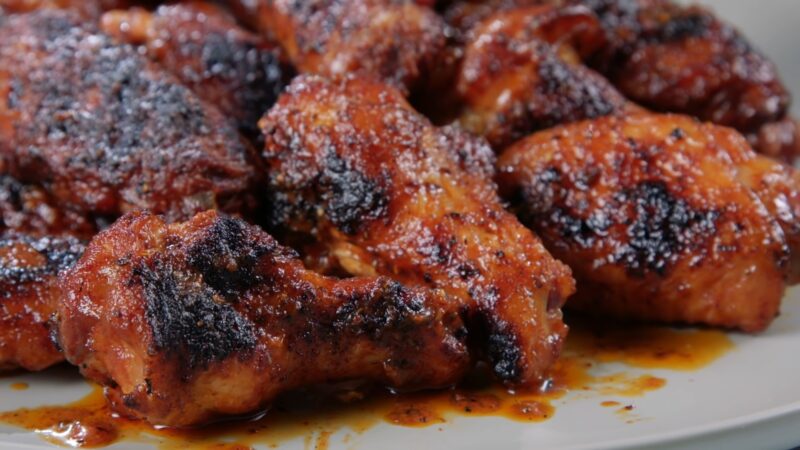
Once your chicken wings are perfectly smoked, it’s time to serve and enjoy them.
Ensure Good Presentation
The way you present your smoked chicken wings can make a big difference in how they are received. Arrange them on a platter with some fresh herbs and lemon wedges for a touch of color and freshness. If you’ve used a sauce, make sure the wings are well-coated and glistening. Some sauces goes perfectly with chicken, such as the white sauce mixed with rice.
Pair with Sides and Drinks
The right sides and drinks can complement the smoky flavor of your wings and enhance the overall dining experience. Here are some classic pairings to consider:
- Sides: Coleslaw, cornbread, baked beans, or a fresh garden salad.
- Drinks: A cold beer, cider, or a refreshing lemonade.
FAQs
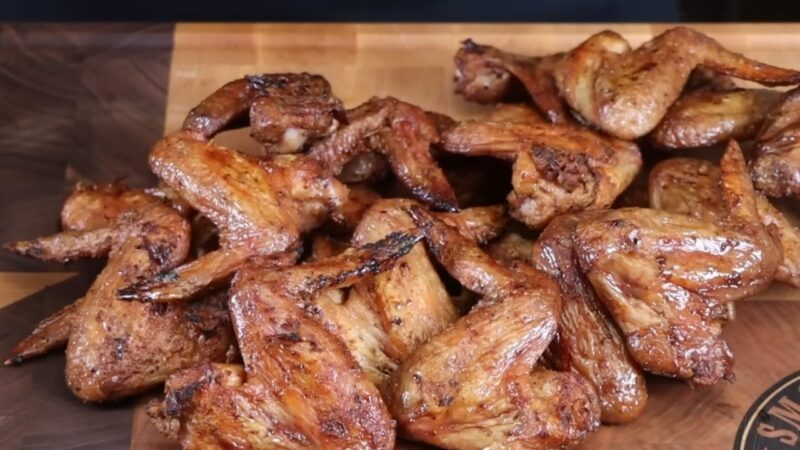
Are Wings Better Grilled or Smoked?
The preference between grilled or smoked wings depends on individual taste. Grilled wings are quicker to prepare and have a crispy exterior, while smoked wings take longer to cook but have a deeper, more complex flavor due to the smoke infusion.
Why Are Smoked Wings Rubbery?
Smoked wings can turn out rubbery if the skin doesn’t have a chance to render and crisp up. This can happen if the smoking temperature is too low or the wings are not smoked for long enough. To avoid rubbery skin, make sure to smoke the wings at the right temperature and for enough time to allow the fat under the skin to render.
Is Smoked Chicken Worth It?
Smoked chicken offers a unique flavor that is hard to achieve with other cooking methods. The process of smoking allows the meat to absorb the flavors from the wood chips, resulting in a rich and savory taste.
Can You Smoke Fully Cooked Wings?
Yes, you can smoke fully cooked wings to add a smoky flavor. However, since the wings are already cooked, you only need to smoke them for a short period of time to infuse the flavor, typically around 30 minutes at a low smoking temperature.
Should You Fry Wings After Smoking?
Frying wings after smoking, also known as “smoke-frying,” can give you the best of both worlds: the rich flavor of smoked wings and the crispy texture of fried wings. To do this, smoke the wings until they are fully cooked, and then fry them in hot oil for a few minutes until the skin is crispy.
The Bottom Line
Smoking chicken wings is a perfect cooking method that can secure delicious and flavorful results. By understanding the relationship between temperature, time, and flavor, you can ensure the right results each time and impress your friends and family with your culinary skills.

